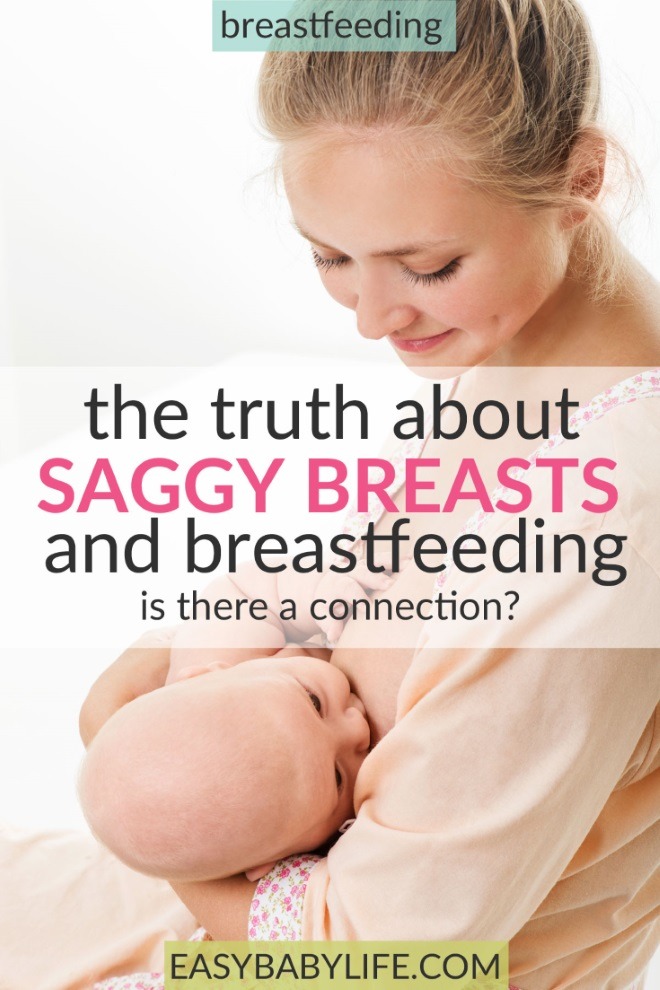
Sitting there with a beautiful baby bump or even nursing your new baby, you might be thinking ahead about what will happen after giving birth or after weaning from breastfeeding. What will your post pregnancy body look like? And specifically; what will happen to your post pregnancy breasts?
Will I get saggy breasts from breastfeeding?
Well, at first, if you breastfeed, your breasts will be larger than ever. They will be full, possibly somewhat tender (particularly in the beginning) and they might leak. But in any case, you will have a really nice cleavage.
But then…
Actually, what research says about breastfeeding and saggy breasts may not be exactly what you think!
The Research About Causes of Saggy Breasts
 After weaning your baby or if you decide not to breastfeed, the appearance of your breasts will take another route. Heading south…
After weaning your baby or if you decide not to breastfeed, the appearance of your breasts will take another route. Heading south…
Many women worry that they will get saggy breasts from breastfeeding. Well, it turns out that this is simply not true.
Pregnancy will cause your breasts to sag. And smoking. And getting older.
A study indicates that breastfeeding is not a predictor of saggy breasts.
The study included 93 women of which 58% had a history of breastfeeding. 55% of the women noticed an adverse change in breast shape after pregnancy. And the breasts tended to sag more depending on:
- the woman’s age
- higher BMI
- greater number of pregnancies
- larger pre-pregnancy breasts
- and smoking.
Breastfeeding could not be found as an independent risk factor for sagging breasts.
It is not very surprising that smoking and aging have adverse effects on the breast shape since both these factors have negative effects on skin elasticity. And heavy breast (if you, for example, are very overweight) of course puts a strain on the skin.
So NO, You do not Get Saggy Breasts From Breastfeeding…
So, what does this mean?
Well, if you don’t want sagging breast, don’t have children, especially not lots of them, don’t smoke and don’t grow old… :-D
Or at least quit smoking! And keep your BMI under control.
But don’t let the fear of saggy breasts stop you from breastfeeding your baby! You do not get saggy breasts from breastfeeding!
One might, of course, object that this is only one study of the connection between breastfeeding and sagging breasts. And the researchers do call for more studies in this area. However, there is at least one more study indicating the same result; a study in Italy already in 2004 also reported no connection between breastfeeding and changing breast shape.
(You find link to both these research studies at the bottom of this article.)
So the evidence that you do not get saggy breasts from breastfeeding is definitely out there, even if it is still limited.
Now, if you’re wondering what to do about your saggy breasts, breast augmentation such as implants and lifts are definitely the most effective (but not very natural) way of breast enhancement. This is however expensive and has risks.
Unfortunately, pills and creams have very poor scientific evidence to actually make a difference in firming the breasts. Exercise may help a bit, as well as dealing with possible stretch marks that also affect the appearance of your boobs.
For some ideas on how to take care of your post-pregnancy breasts naturally, click here. (You’ll find a huge number of comments by moms about their breasts post-pregnancy at the bottom of that post too.)
If you are considering breast implants or any other type of surgery, do wait until you are sure that you don’t want more kids. It is only then that you will know the real look of your post-pregnancy breasts. And don’t judge them immediately after giving birth and breastfeeding. It can take up to six months for the breasts to restore some of their usual looks.
Another, much cheaper and healthier way of dealing with you now saggy breasts is to – eh – simply accept them! Love them even. Easier said than done maybe, but give yourself some time! :-)
Want more information about your post-pregnancy body? You’ll find it here.
Research Reference
- The effect of breastfeeding on breast aesthetics.
- Breastfeeding and perceived changes in the appearance of the breasts: a retrospective study

Paula Dennholt founded Easy Baby Life in 2006 and has been a passionate parenting and pregnancy writer since then. Her parenting approach and writing are based on studies in cognitive-behavioral models and therapy for children and her experience as a mother and stepmother. Life as a parent has convinced her of how crucial it is to put relationships before rules. She strongly believes in positive parenting and a science-based approach.
Paula cooperates with a team of pediatricians who assist in reviewing and writing articles.





